
The China Insurance Consumer Confidence Index (CICCI) in Q2 2024 was 70.8, representing a decrease of 0.1 from Q1 2024 and an increase of 3.1 over Q2 2023 and staying within the high confidence range (65, 85], indicating a stable and growing trend. In Q2, insurance industry and individual spending saw a considerable increase in insurance consumer confidence compared to Q2 2023. As a result, the basis for maintaining and boosting insurance customer confidence keeps getting stronger.

Figure 1 Movement of CICCI since 2021
In terms of insurance types, the life insurance consumer confidence index and the property insurance consumer confidence index in Q2 2024 were 71.5 and 70.1 respectively, with the former keeping within the high confidence range for seven consecutive quarters and the latter doing the same for two consecutive quarters.
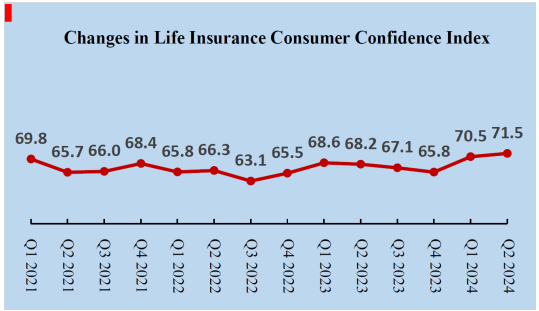
Figure 2 Changes in Life Insurance Consumer Confidence Index
In Q2 2024, the life insurance consumer confidence index was 71.5, up 1.0 over Q1 2024 and up 3.3 from Q2 2023, staying within the high confidence range and reaching the highest value since Q1 2021. Its indicators showed the following trends:
On a quarter-on-quarter basis, there were two rises and one fall in the three primary indicators, with confidence in individual spending rising significantly. Three primary indicators stay within the high confidence range. There were three rises, one flat and two falls in the six secondary indicators, with confidence in insurance service satisfaction, consumer trust willingness and insurance spending willingness rising, confidence in perceived industry policies unchanging, and confidence in economic environment and industry development falling. All secondary indicators stay within the high confidence range.
On a year-on-year basis, three primary indicators, which make up the index, rose, with confidence in individual spending rising the most. Of the six secondary indicators, five rose and one fell, with confidence in economic environment, perceived industry policies, insurance service satisfaction, consumer trust willingness and insurance spending willingness rising, and confidence in industry development falling. Perceived industry policies, insurance service satisfaction, consumer trust willingness and insurance spending willingness were the highest since Q1 2021.
According to the survey on eight popular life insurance products in Q2, the index of willingness to purchase six different insurance products, including health, accident, term life, permanent life, annuity and universal insurance, was greater than 50%, staying within the more positive range. The top three were as follows:
The index of willingness to purchase health insurance was 77.2, with 59.3% of consumers believing that the possibility of purchasing health insurance “will increase”, 36.4% believing that the possibility “will basically remain unchanged”, 4.3% believing that the possibility “will decrease”.
The index of willingness to purchase accident insurance was 73.3, with 52.5% of consumers believing that the possibility of purchasing accident insurance “will increase”, 41.4% believing that the possibility “will basically remain unchanged”, and 6.0% believing that the possibility “will decrease”.
The index of willingness to purchase term life insurance was 66.6, with 37.7% of consumers believing that the possibility of purchasing term life insurance “will increase,” 57.8% believing that the possibility “will basically remain unchanged,” and 4.5% believing that the possibility “will decrease”.
A favorable climate for insurance consumption is currently being created by the fact that consumer confidence in life insurance is still rising, and that consumer confidence in perceived industry policies, consumer trust willingness, insurance spending willingness and insurance service satisfaction are all at high levels compared to the same historical period. The increased awareness of risk protection among consumers has led to a more rational application of insurance. Consumers find protection insurance products—such as health, accident, and endowment—more appealing than financial insurance products when it comes to risk protection. Future increases in consumer demand for life insurance are anticipated. It is recommended that market players pay attention to the trend of consumers’ purchasing willingness, optimize the supply of insurance products in a timely manner, and meet consumers’ needs in a targeted manner.
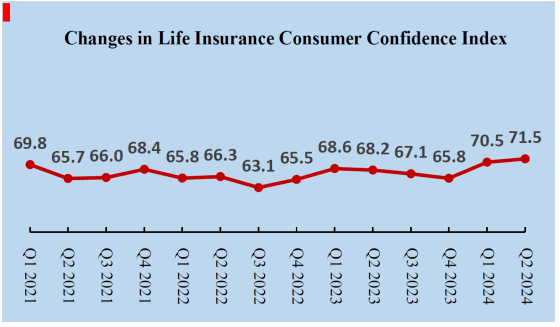
Figure 3 Changes in Property Insurance Consumer Confidence Index
In Q2 2024, the property insurance consumer confidence index was 70.1, down 1.2 over Q1 2024 and up 2.8 from Q2 2023, staying within the high confidence range. Its indicators showed the following trends:
On a quarter-on-quarter basis, there were one rise and two falls in the three primary indicators, with confidence in individual spending rising, and confidence in macro-environment and insurance industry falling. Of the three primary indicators, confidence in insurance industry and individual spending stayed within the high confidence range. There were two rises, one flat and three falls in the six secondary indicators, with confidence in consumer trust willingness and insurance spending willingness rising, confidence in insurance service satisfaction unchanging, and confidence in economic environment, industry development and perceived industry policies falling.
On a year-on-year basis, there were two rises and one fall in the three primary indicators, with confidence in insurance industry and individual spending rising, and confidence in macro-environment falling. Of the six secondary indicators, four rose and two fell, with confidence in perceived industry policies, insurance service satisfaction, consumer trust willingness and insurance spending willingness rising, and confidence in economic environment and industry development falling. Insurance service satisfaction, consumer trust willingness and insurance spending willingness were the highest since Q2 2023.
According to the survey on six popular property insurance products in Q2, the index of willingness to purchase six different insurance products, including back freight, new energy vehicle, family property, fuel vehicle, account security, and flight delay insurance was greater than 50%, staying within the more positive range. The top three were as follows:
The index of willingness to purchase back freight insurance was 72.0, with 53.1% of consumers believing that the possibility of purchasing back freight insurance “will increase”, 37.8% believing that the possibility “will basically remain unchanged”, 9.1% believing that the possibility “will decrease”.
The index of willingness to purchase new energy vehicle insurance was 71.9, with 55.2% of consumers believing that the possibility of purchasing new energy vehicle insurance “will increase”, 33.3% believing that the possibility “will basically remain unchanged”, 11.5% believing that the possibility “will decrease”.
The index of willingness to purchase family property insurance was 66.1, with 41.9% of consumers believing that the possibility of purchasing family property insurance “will increase,” 48.5% believing that the possibility “will basically remain unchanged,” and 9.6% believing that the possibility “will decrease”.
The current property insurance consumer confidence index continues to enjoy a good momentum for growth. Consumer confidence in insurance service satisfaction, consumer trust willingness and insurance spending willingness are all at relatively high levels over the past four quarters. The relevant departments have been encouraging large-scale equipment renewal and consumer goods trade-in programs, and many places have started offering automobile trade-in policy subsidies. These initiatives are anticipated to increase automobile sales, and the willingness of customers for purchasing vehicle insurance is in the positive range, creating a climate that is conducive to property insurance consumption. It is recommended that industry players pay close attention to the trend of consumers’ insurance consumption demand and take advantage of the recent steady progress in consumer confidence to further optimize the supply of products, including new energy vehicle insurance, to satisfy consumers’ various demands for property risk protection.
The CICCI in Q2 2024 made progress amid overall stability. The policies on ensuring stability in expectations, growth and employment keep up the strong momentum, and the benefits of macro policies have been progressively felt, contributing to the sustained recovery and development of insurance consumer confidence. The index of consumers’ willingness to purchase popular insurance products, released for the first time this quarter, is largely in the positive range, indicating that the consumption of insurance products is continuing its steady upward trajectory. It is recommended that market players take advantage of the stable and improving consumer confidence, integrate their own operations and development with safeguarding the country’s overall development and the people’s welfare, perform solidly in the “five priorities” of technology finance, green finance, inclusive finance, pension finance and digital finance, keep building the foundation of insurance consumer confidence, and support the industry’s high-quality development.
Annex 1: CICCI Scores for Q2 2024

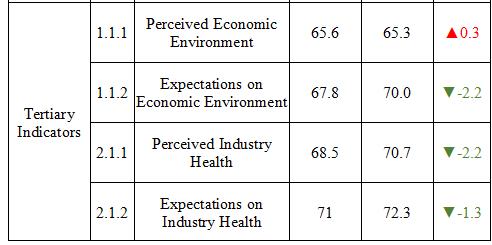
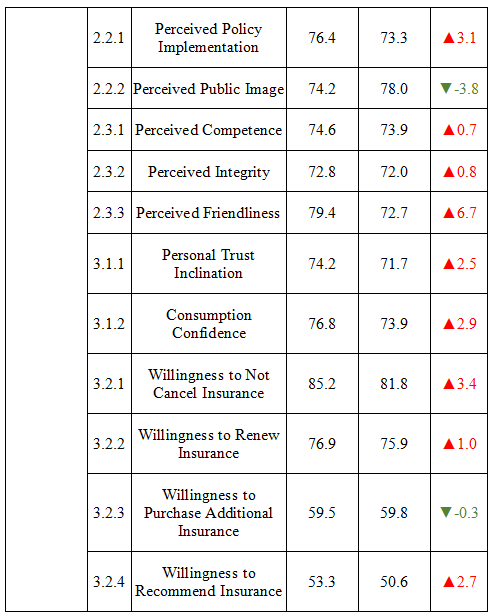
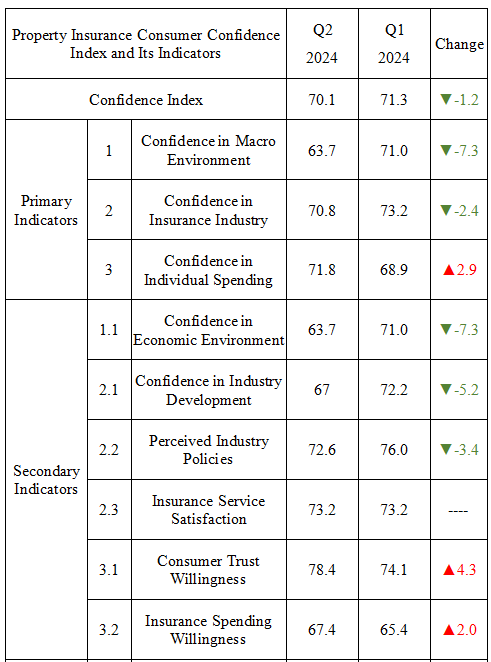
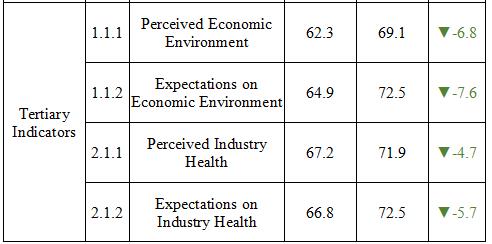
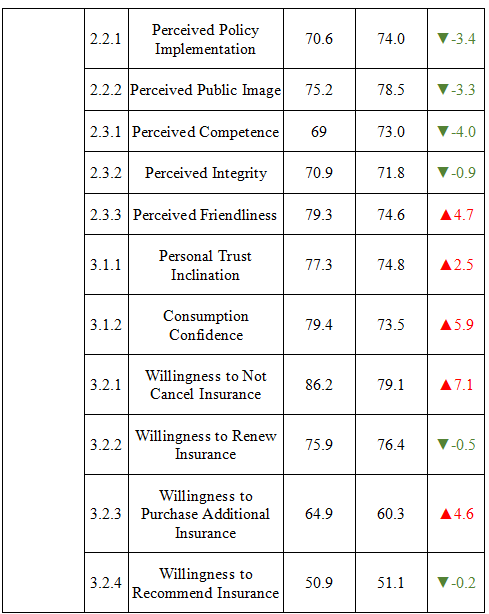
Annex 2: Scores on the Index of Willingness to Purchase Insurance Products for Q2 2024
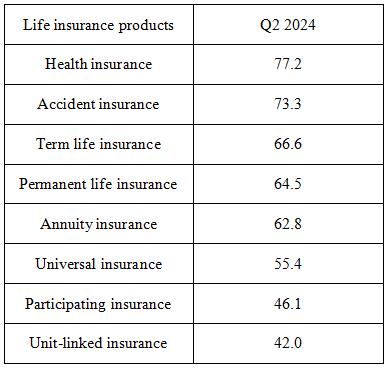
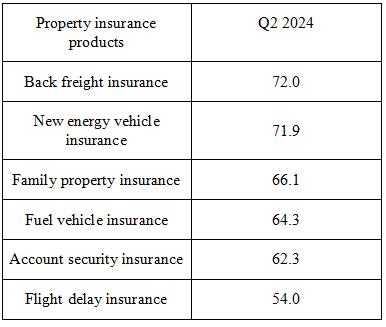
Notes on the Compilation of CICCI:
China Insurance Consumer Confidence Index (CICCI) survey covers 18 provinces, autonomous regions, and municipalities in Northeast, North, East, South, Central, Northwest, and Southwest China. These regions account for more than 90% of the national net premium written.
This round of survey uses a combination of two-phase stratified sampling, probability proportional to size (PPS) sampling, and random telephone sampling to collect 1,071 valid responses for inclusion in the index, comprising 531 from the life insurance segment and 540 from the property insurance segment. The online survey is completed with a big data-driven sampling frame and an AI-powered call system without human intervention. After a consumer answers the phone call and confirms his/her willingness to participate, the system will automatically send him/her a text message containing a link to the online survey form. This implementation ensures both consumer privacy and first-hand access to feedback.
CICCI gives a value from the [0, 100] range, 50 being the neutral result. A score higher than 50 indicates optimism, i.e. a larger proportion of insurance consumers is optimistic rather than pessimistic. The higher the score, the stronger the consumer confidence. Score ranges have the following meanings: (85, 100]: Very high confidence; (65, 85]: High confidence; (50, 65]: Average confidence; (35, 50]: Below-average confidence; (15, 35]: Low confidence; and (0, 15]: No confidence.
A straightforward diffusion index method is used to create the sentiment index, which measures willingness to purchase insurance products as the weight of “rising” minus the weight of “falling”, i.e., the percentage of positive responses plus half of the percentage of unaltered responses. The formula is as follows: Willingness to purchase = Percentage of “enhancement” option ×1 + Percentage of “no change” option × 0.5. Values taken are between [0, 100], with 50 being the neutral value. The willingness to purchase is said to be in the more positive range if the value is greater than 50, and the more negative range if the value is lower than 50.

